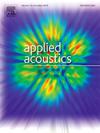Design of broadband dish-shaped transducer with giant magnetostrictive material
IF 3.4
2区 物理与天体物理
Q1 ACOUSTICS
引用次数: 0
Abstract
In this paper, based on giant magnetostrictive material (GMM), a low frequency, broadband and high power underwater dish transducer (UDT) is proposed and optimized in considering of the coupling factors of electromagnetic–mechanical-acoustic multiple physical fields. Firstly, to reduce the influence of non-uniform magnetic field distribution of GMM rod on acoustic wave quality, a multi-rod magnetic circuit structure is designed. Secondly, the vibration mode of UDT is analyzed, and the influence of different structural parameters on the sensitivity of the output wave response is explored. Finally, in order to achieve the target requirements of low frequency and broadband, this paper combines the U-net neural network and Grey Wolf algorithm improved particle swarm optimization, by this way, which can optimize the total ability in terms of both magnetic circuit structure and mechanical structure. The optimized simulation results show that the maximum transmit current response (TCR) is 187.15 dB and the undulation within the band is 5.03 dB. A prototype is manufactured based on the optimized design parameters. The experimental results show that the maximum TCR of the prototype developed in the target water depth is 187.32 dB, the undulation within the band is 5.36 dB, and the performance is good, which verifies the feasibility and accuracy of the design method.
利用巨磁致伸缩材料设计宽带碟形换能器
本文基于超磁致伸缩材料(GMM),在考虑电磁-机械-声多物理场耦合因素的基础上,提出并优化了一种低频、宽带、大功率水下碟形换能器(UDT)。首先,为了减小磁棒磁场分布不均匀对声波质量的影响,设计了多棒磁路结构;其次,分析了UDT的振动模态,探讨了不同结构参数对输出波响应灵敏度的影响。最后,为了实现低频宽带的目标要求,本文将U-net神经网络与改进的灰狼算法粒子群优化相结合,通过这种方式,可以从磁路结构和机械结构两方面对总能力进行优化。优化后的仿真结果表明,最大发射电流响应(TCR)为187.15 dB,带内波动为5.03 dB。根据优化后的设计参数制作了样机。实验结果表明,研制的样机在目标水深处的最大TCR为187.32 dB,带内波动为5.36 dB,性能良好,验证了设计方法的可行性和准确性。
本文章由计算机程序翻译,如有差异,请以英文原文为准。
求助全文
约1分钟内获得全文
求助全文
来源期刊

Applied Acoustics
物理-声学
CiteScore
7.40
自引率
11.80%
发文量
618
审稿时长
7.5 months
期刊介绍:
Since its launch in 1968, Applied Acoustics has been publishing high quality research papers providing state-of-the-art coverage of research findings for engineers and scientists involved in applications of acoustics in the widest sense.
Applied Acoustics looks not only at recent developments in the understanding of acoustics but also at ways of exploiting that understanding. The Journal aims to encourage the exchange of practical experience through publication and in so doing creates a fund of technological information that can be used for solving related problems. The presentation of information in graphical or tabular form is especially encouraged. If a report of a mathematical development is a necessary part of a paper it is important to ensure that it is there only as an integral part of a practical solution to a problem and is supported by data. Applied Acoustics encourages the exchange of practical experience in the following ways: • Complete Papers • Short Technical Notes • Review Articles; and thereby provides a wealth of technological information that can be used to solve related problems.
Manuscripts that address all fields of applications of acoustics ranging from medicine and NDT to the environment and buildings are welcome.
 求助内容:
求助内容: 应助结果提醒方式:
应助结果提醒方式:


